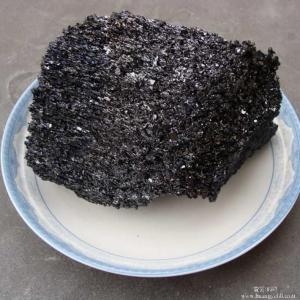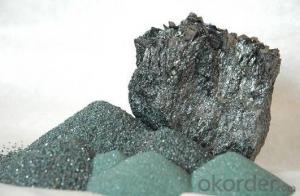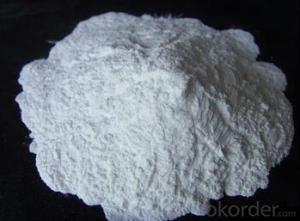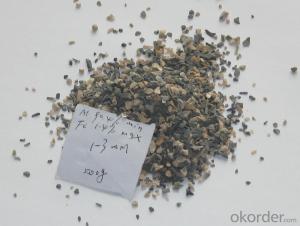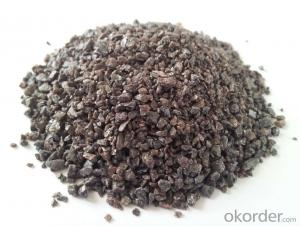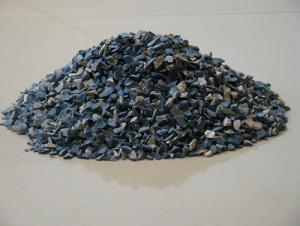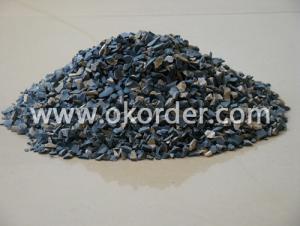Black Silicon Carbide Powder Price 3-5mm SiC 98.5% with Best Price/China Manufacture
- Loading Port:
- Tianjin
- Payment Terms:
- TT or LC
- Min Order Qty:
- 25 m.t.
- Supply Capability:
- 3000 m.t./month
OKorder Service Pledge
OKorder Financial Service
You Might Also Like
Black Silicon Carbide Powder Price 3-5mm SiC 98.5% with Best Price/China Manufacture
1.Structure of Silicon Carbide Description
Black Silicon Carbide is produced with high temperature in a electric resistant furnace from a mixture of quartz sand and petroleum coke.
Black silicon carbide is typically used for working on cast iron ,non-ferrous metals, stone, leather, rubber, and other materials which requires sharp cutting characteristics. The mineral is also used widely as a refractory material and metallurgical additive.
2.Main Features of the Calcined Bauxite
Its hardness is between that of fused alumina and synthetic diamond and mechancial intensity of it is also greater than that of fused alumina. It is brittle and very sharp and has a certain degree of electrical and heat conductivity.
3.Main usage of the Calcined Bauxite
1.Grinding non-ferrous materials, rock, stone, leather, rubber, finishing tough and hard materials
2.Bonded abrasive tools, lapping and polishing
3.Widely used as a metallurgical additive and refractory material
4.Refractory
4. Calcined Bauxite Images
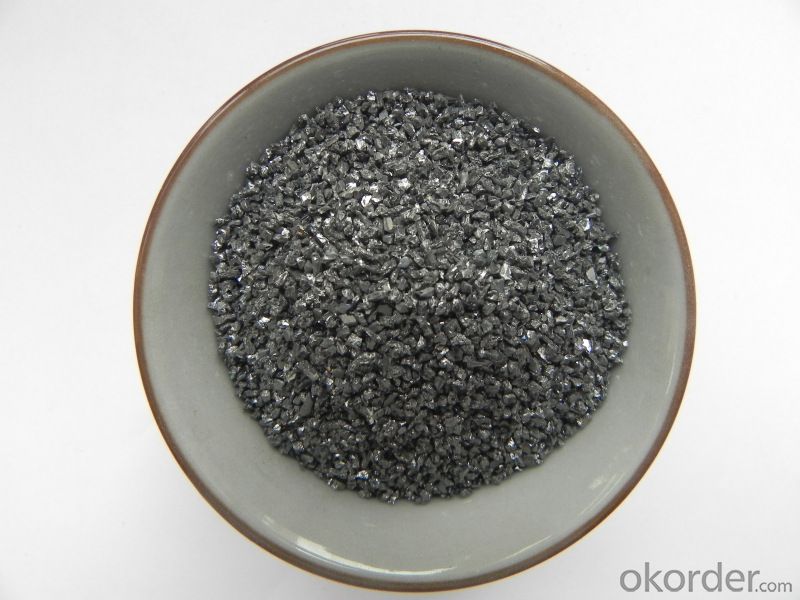
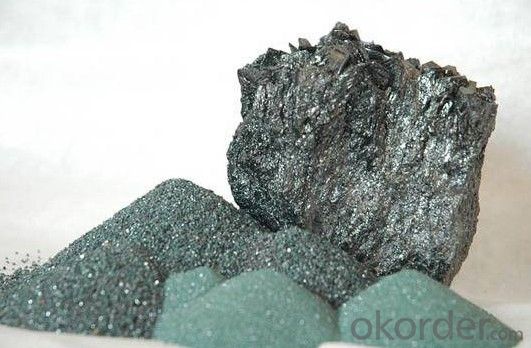
5. Calcined Bauxite Specification
Grit | SiC | F.C. | Fe2O3 |
F12-F90 | 98.50%min | 0.20%max | 0.60%max |
F100-F150 | 98.00%min | 0.30%max | 0.80%max |
F180-F220 | 97.00%min | 0.30%max | 1.20%max |
F230-F400 | 96.00%min | 0.40%max | 1.20%max |
F500-F800 | 95.00%min | 0.40%max | 1.20%max |
F1000-F1200 | 93.00%min | 0.50%max | 1.20%max |
P12-P90 | 98.50%min | 0.20%max | 0.60%max |
P100-P150 | 98.00%min | 0.30%max | 0.80%max |
P180-P220 | 97.00%min | 0.30%max | 1.20%max |
P230-P500 | 96.00%min | 0.40%max | 1.20%max |
P600-P15000 | 95.00%min | 0.30%max | 1.20%max |
P2000-P2500 | 93.00%min | 0.50%max | 1.20%max |
6.FAQ of Calcined Bauxite
1). Q: Are you a factory or trading company?
A: We are a factory.
2). Q: Where is your factory located? How can I visit there?
A: Our factory is located in Ningxia, China. You are warmly welcomed to visit us!
3). Q: How can I get some samples?
A: Please contact me for samples
- Q:Who knows what kind of fire prevention materials are there?
- 1, Fire-proof board Fire-proof board is the most frequently used materials in the market. There are two kinds of fireproof boards which are commonly used; one is the high pressure decorative board, which has the advantages of fire prevention, damp proof, abrasion resistance, oil resistance, easy cleaning, and more variety of colors and designs. The other one is a glass magnesium fire board, the outer layer of which is a decorative material, the inner layer of which is a mineral glass magnesium fire material. It can resist 1500-degrees high temperature, but not suit for decoration. The installation of fireproof ceiling in the exit passageway, stair well and corridor can ensure safety evacuation, and protect people from the spread of the fire. 2 Fire-proof door Fireproof door is divided into wooden fire proof door, steel fire proof door and stainless steel fire proof door. Usually the fire proof door is used for the opening of the firewall, the entrance to the staircase, the evacuation of the aisle, the openings of the pipeline and other parts of the building, and it has an important role in fire separation and reducing the loss from fire. 2 Fire resisting shutter I hope it may be helpful to you.
- Q:What materials is silicious thermal insulation board made of?
- Siliceous insulating panels use quartz sand as the main material and are composited with fiber. Of course the amount of insulation board materials used by different companies is different. In terms of Hua Heng, siliceous insulating boards can be divided into insulating panels for casting slabs and insulation board for intermediate tank according to the usage. The latter one can be divided into liner plate (wallboard, side panels, baseboard) and impingement plate based on parts it is used on. Siliceous insulating panels use quartz sand as the main material and are composited with fiber. Method for manufacturing a silicon insulating panel is divided into semi-dry method and wet method. It is used for casting ingot insulation cap of the killed steel and continuous casting tundish.
- Q:Can anyone tell me what is a high alumina refractory?
- Refractories refer to a class of inorganic non-metallic materials whose refractoriness are no less than 1580 ℃. Refractoriness is the Celsius temperature when cone-shaped samples can resist high temperature without softening and melting down in the absence of a load. But it is not accurate to define refractory merely by judging that whether the refractoriness is no less than 1580 ℃. Currently, the materials whose physical and chemical properties allow them to be used in high temperature environments are called refractories. Refractory materials are widely used in metallurgy, chemical industry, petroleum, machinery manufacturing, power and so on, among which the metallurgical industry is the largest demander in this regard, accounting for 50% to 60% of total output. Hope it will help you out!
- Q:What are the characteristics of the carbon composite refractories?
- The features of carbon composite refractories: 1. It is with an aggressive high thermal shock resistance 2. Good resistance to molten steel and slag
- Q:How to use fireclay?
- Actually, fire clay is not strong. Fireclay are all clinkers with no strength, also known as "blade mud". It is used as the filler with a thickness of not more than 3mm. Therefore, it can not be used for thermal insulation inside the furnace. Inner thermal insulation of the civil boiler can use "alumina cement", also known as refractory cement.
- Q:How should fireproof building materials be ranked?
- According to our national standard GB8624-97, the combustion performance of building materials are divided into the following levels: A class: Incombustible building materials: the material is almost incombustible. B1 class: Flame-retardant building materials: they are better in fire retardation. It is non-combustible when meeting open fire in the air or under high temperature, and it is difficult for the fire to spread quickly. Besides, when the fire source is removed, combustion stops immediately. B2 class: Combustible building material: It has certain fire retardation. In case of open fire in the air or at high temperature, it will immediately burst into flames, and easily lead to the spread of fire, such as the spread to wooden pillars, timber roof truss, timber beams, wood stairs, etc. B3 class: Flammable building material: It has no fire retardant effect at all, but is highly flammable with high fire risk. Hope my answer can be accepted.
- Q:Pals who know something about fire resistant material please tell me how many types of refractory material there are
- There are a variety of refractory materials, each of different use. It is necessary to make resonable classification for refractory materials so as to facilitate scientific research, rational selection and management. There are many kinds of classification methods for refractory materials, including classification based on chemical property, chemical mineral composition, production process, material form and other methods. 1, according to the capacity of fire resistance: ordinary refractory materials: 1580 degrees C ~1770 C Advanced Refractory Materials: 1770 degrees ~2000 degrees c: Classification according to product shape and size: standard 230mm×113mm×65mm no more than 4 scales
- Q:What are the requirements for the performance of refractory materials?
- Refractory materials should have very high refractoriness, high temperature heat load and resistance to softening, melting; with high volume stability, resistance to high temperature and heat load, volume shrinkage and only uniform expansion; high strength at room temperature and high temperature strength, high load softening temperature, under the joint action of heat load and heavy load, no loss of strength, creep collapse; Electric furnace analysis should have good resistance to thermal shock, resistance to rapid temperature changes, no crack, not flaking; with excellent slag resistance.
- Q:Are fire materials poisonous after burning?
- Refractories burning after the smell of toxic, gases are generally silica, alumina, sulfur oxides and so onRefractory material is not less than 1580 degrees of refractoriness, better thermal shock resistance and chemical erosion, low thermal conductivity and low expansion coefficient of non-metallic materials. Acid refractory with silicon oxide as the main component, are commonly used in brick and clay brick. Silica is silica containing more than 94% silica products, raw materials used in silica, silica and other waste, the acid resistance of slag erosion ability, high load softening temperature, volume shrinkage after repeated burning, or even a slight expansion; but it is vulnerable to the erosion of basic slag, thermal shock resistance is poor. The brick is mainly used for thermal equipment of glass furnace, coke oven, acid furnace etc.. Clay brick with refractory clay as the main raw material, containing 30% to 46% of alumina, weak acid refractory material, refractory material, good heat shock resistance, resistance to acid slag, widely used.
- Q:what are the types of piping insulation material fire?rating?
- There are two grades: 1, the organic material: Grade B Grade B1 hard combustion (fire?retardant) 2, inorganic materials: class A no burning it is divided into three levels, attributed to the types of materials!
1. Manufacturer Overview |
|
|---|---|
| Location | |
| Year Established | |
| Annual Output Value | |
| Main Markets | |
| Company Certifications | |
2. Manufacturer Certificates |
|
|---|---|
| a) Certification Name | |
| Range | |
| Reference | |
| Validity Period | |
3. Manufacturer Capability |
|
|---|---|
| a)Trade Capacity | |
| Nearest Port | |
| Export Percentage | |
| No.of Employees in Trade Department | |
| Language Spoken: | |
| b)Factory Information | |
| Factory Size: | |
| No. of Production Lines | |
| Contract Manufacturing | |
| Product Price Range | |
Send your message to us
Black Silicon Carbide Powder Price 3-5mm SiC 98.5% with Best Price/China Manufacture
- Loading Port:
- Tianjin
- Payment Terms:
- TT or LC
- Min Order Qty:
- 25 m.t.
- Supply Capability:
- 3000 m.t./month
OKorder Service Pledge
OKorder Financial Service
Similar products
New products
Hot products
Hot Searches
Related keywords
